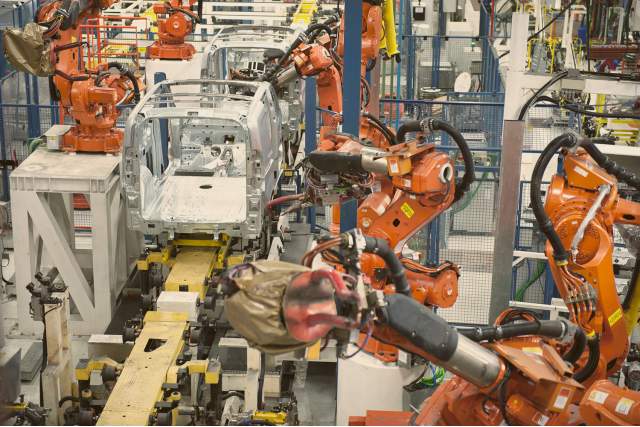No Assembly Required
Is retaining manufacturing essential to the American economy’s long-run growth and prosperity? Tuck professor Andrew Bernard finds that de-industrialization has some surprises.

The current definition of a manufacturing firm is very limiting, says Tuck professor Andrew Bernard.
Back in November, when President-elect Donald Trump coerced the Carrier Corporation to keep 1,000 jobs in its Indiana gas-burner factory from moving to Mexico, he was acting under the common belief that manufacturing is a boon to the economy.
Why? Because factory jobs are perceived to offer good wages to workers with little or no college education, and industrial sectors have historically displayed high growth rates of productivity. So Carrier’s plan to get rid of 2,000 American jobs was one more example of a much-maligned economic shift called de-industrialization, a hollowing-out of factory towns that has cost the U.S. 5 million manufacturing jobs since the year 2000.
Leaders of many other high-income nations share Trump’s aversion to de-industrialization, and, like Trump, they have taken steps to reverse the trend, declaiming it as a threat to the current standard of living and future income levels. France, for example, created a position in 2012 called the Minister of Industrial Recovery. Andrew Bernard, the Jack Byrne Professor of International Economics at Tuck, wondered if those efforts make sense. So he decided to take a close look at what really happens to firms and workers when companies exit the manufacturing sector.
In “Rethinking Deindustrialization,” an article forthcoming in Economic Policy, Bernard and co-authors Valerie Smeets and Frederic Warzynski of Aarhus University study deindustrialization in Denmark between 1980 and 2013. They find that a substantial number of firms exit the manufacturing sector and yet retain the good qualities frequently ascribed to the industrial world, such as high growth and productivity. Their conclusions, in Bernard’s words, raise an important question: “Is the label ‘manufacturing’ correctly associated with what we value and what we want?” he says.
Bernard and his co-authors begin the article with a key reminder. In order for a firm to be considered a “manufacturer,” at least in the eyes of economists and policy makers tracking jobs statistics, it must be involved in the production process—the physical assembly of a product. This is a very limiting definition. That’s a problem for proponents of manufacturing because, as Bernard discovered in his research, there’s a growing number of companies that are performing a lot of high-value tasks associated with creating a good, such as innovation, design, engineering, marketing, and sales, while offshoring the one component—assembly—that would qualify them as a manufacturer.
Bernard calls these firms “switchers.” A perfect example is Apple. It started out by making the products it invented in house. Now it does everything it used to do except the assembly, which in many cases it delegates to factories in China owned by unrelated companies. These switchers, hybrids that blend service with manufacturing, have some interesting qualities. They usually have fewer employees than companies that remain in manufacturing, but they also have higher sales and more value added per worker. These types of firms defy categorization. “In most respects they differ substantially from both manufacturing and service sector firms,” the authors write. “They have more than twice as many R&D/tech workers and almost twice as many managers.”
The companies that exit manufacturing usually do it for a calculated reason: they can’t be competitive while paying American wages for assembly work.
The companies that exit manufacturing usually do it for a calculated reason: they can’t be competitive while paying American wages for assembly work. So they offshore the lowest value component of their process to countries where labor costs are lower. At the same time, they increase the number of white collar employees and hold on to the high-value portions of their business. This makes good economic sense in a free market, and causes the type of economic growth traditionally associated with manufacturing. This is the central conclusion of Bernard’s article. It turns out we don’t need to build stuff to have a strong economy.
So in order to boost manufacturing in countries like the U.S., there needs to be other incentives. And they were in the deal Trump struck with Carrier: a $7-million tax break from the State of Indiana, and the threat of ending some lucrative government contracts. “I think you can view his heart as being in the right place,” Bernard says of Trump’s efforts with Carrier. “He wants to preserve high-paying jobs for a certain part of the workforce. I worry the tactics he’s using may actually end up driving new versions of those companies out of the U.S., because this won’t necessarily be the low-cost place to produce.”
Even with the good news about switchers picking up where manufacturers left off, they still aren’t hiring blue-collar workers like factories did during most of the 20th century. “There’s no doubt that the workers with a few years of college or less have been left behind in this transformation,” Bernard says. “No one has come up with the solution for that group.”

